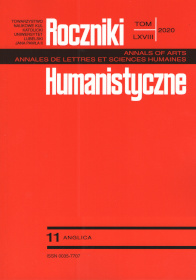Frontier Imagery in Gentrification Narratives: Andrew Wingfield’s Short Story Cycle Right of Way (2010)
Abstract
This paper investigates Andrew Wingfield’s use of the frontier myth in the short‑story cycle Right of Way (2010), set in a contemporary urban neighborhood undergoing gentrification. Using Frederick Jackson Turner’s notion of the frontier and the Chicago School’s urban ecology as a theoretical backdrop, I explore the ways in which Wingfield both deploys and challenges the imagery of the frontier and the invasion–succession model of the ecological paradigm. I argue that, while the frontier myth most likely appeals to the Americans’ self-identity as a nation, Wingfield uses the myth as the warp on which to weave a nuanced picture of the new urban frontier, with a focus on micro-level interactions and attachments that produce a sense of place.
References
Barthes, Roland. Mythologies. 1972. Vintage, 1992.
Burgess, Ernest W. “The Growth of the City: An Introduction to a Research Project.” The City Reader, edited by Richard T. LeGates and Frederic Stout, 2nd ed., Routledge, 1996, pp. 153–61.
“Cleave, v.1.” OED Online, Oxford UP, March 2020, www.oed.com/view/Entry/34105. Accessed 14 May 2020.
“Cleave, v.2.” OED Online, Oxford UP, March 2020, www.oed.com/view/Entry/34106. Accessed 14 May 2020.
Cresswell, Tim. “Place.” Encyclopedia of Human Geography, edited by Barney Warf, Sage Publications, 2006, pp. 358–56.
Dear, Michael. “Los Angeles and the Chicago School: Invitation to a Debate.” Cities and Society, edited by Nancy Kleniewski, Blackwell Publishing, 2005, pp. 54–71.
Dybska, Aneta. Regeneration, Citizenship, and Justice in the American City since the 1970s. Peter Lang, 2016.
Florida, Richard. The Rise of the Creative Class. And How It’s Transforming Work, Leisure, Community and Everyday Life. Basic Books, 2002.
High Noon. Directed by Fred Zinneman. United Artists,1952.
Lees, Loretta, et al. Gentrification. Routledge, 2008.
Kuhlke, Olaf. “Urban Spatial Culture.” Encyclopedia of Human Geography, edited by Barney Warf, Sage Publications, 2006, pp. 525–27.
Limerick, Patricia Nelson. The Legacy of Conquest: The Unbroken Past of the American West. Norton, 1987.
Nas, Peter J. M. “Social Ecology in Urban Setting.” Encyclopedia of Life Support Systems. www.eolss.net/Sample-Chapters/C11/E1-11-02-05.pdf. Accessed 10 May 2020.
Park, Robert E., Ernest W. Burgess, and Roderick D. McKenzie. The City. U of Chicago P, 1925.
Pettegrew, John. Brutes in Suits: Male Sensibility in America, 1890–1920. Johns Hopkins UP, 2007.
Popper, Deborah. “Invasion–Succession.” Encyclopedia of Human Geography, edited by Barney Warf, Sage Publications, 2006, pp. 262–63.
Price, Jenny. “Thirteen Ways of Seeing Nature in Los Angeles: Part 1.” The Believer, 1 Apr. 2006, believermag.com/thirteen-ways-of-seeing-nature-in-la/. Accessed 14 May 2020.
Proshansky, Harold M., et al. “Place-Identity: Physical World Socialization of the Self.” 1983. The People, Space, and Place Reader, edited by Jen Jack Gieseking and William Mangold, with Cindi Katz et al., Routledge, 2014, pp. 77–86.
“Right of way.” OED Online, Oxford UP, March 2020. www.oed.com/view/Entry/165900. Accessed 14 May 2020.
Sack, Robert D. Homo Geographicus. Johns Hopkins UP, 1997.
Slotkin, Richard. Gunfighter Nation: The Myth of the Frontier in Twentieth-Century America. U of Oklahoma P, 1992.
Smith, Neil. “Building the Frontier Myth.” The Gentrification Debates: A Reader, edited by Japonica Brown-Saracino, Routledge, 2010, pp. 113–17.
O’Sullivan, John L. “The Great Nation of Futurity.” Democratic Review, vol. 6, no. 23, 1839, pp. 426–30. www.durmushocaoglu.com/data/kutuphane/17_The_Great_Nation_of_Futurity.pdf.
Tuan, Yi-Fu. Topophilia. A Study of Environmental Perception, Attitudes, and Values. Prentice Hall, 1974.
Turner, Frederic Jackson. “The Significance of the Frontier in America.” The American Intellectual Tradition: A Sourcebook, edited by David A. Hollinger and Charles Capper, vol. 1–2, Oxford UP, 1989, pp. 521–25.
Warf, Barney. “Neighborhood Change.” Encyclopedia of Human Geography, edited by Barney Warf, Sage Publications, 2006, pp. 325–26.
Wingfield, Andrew. Right of Way. Washington Writers’ Publishing House, 2010.
Wright, Will. “The Structure of Myth & The Structure of the Western Film.” Cultural Theory and Popular Culture: A Reader, edited by John Storey, Pearson Prentice Hall, 2006, pp. 293–302.
Zukin, Sharon. Naked City. The Death and Life of Authentic Urban Places. Oxford UP, 2010.
Copyright (c) 2020 Roczniki Humanistyczne

This work is licensed under a Creative Commons Attribution-NonCommercial-NoDerivatives 4.0 International License.





